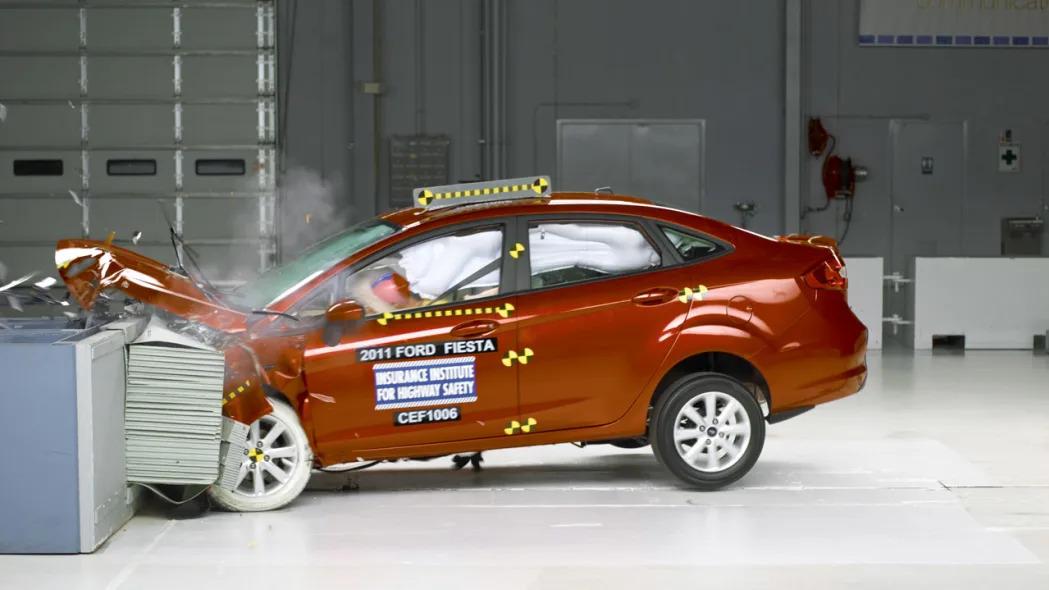2011 Ford Fiesta offset barrier crash test – Click above for high-res image gallery
One of the long-time knocks against small cars has been that they sacrifice safety for efficiency. However, modern crash simulation and testing technology, as well as material science, is making that complaint a thing of the past. Case in point: the 2011 Ford Fiesta has just scored a Top Safety Pick from the Insurance Institute for Highway Safety (IIHS).
The Fiesta is the first B-segment car to get the top ranking since IIHS added new roof crush requirements to its rating system. Extensive computer simulation has allowed body engineers to tailor the use of high-strength steels and conventional steels in order to direct the energy of an impact into areas of the body that won't affect the occupants. Designing in paths that collapse in a controlled manner helps to keep the passenger cell intact and, in many cases, like the one shown above, the doors still open normally even after the collision.
The performance of the Fiesta is particularly impressive since Ford has managed to avoid the very thick pillars found on many other newer cars. Those thick pillars can create very large blind spots increasing the chance of a collision.
[Source: Ford]
PRESS RELEASE
SMALL IS SAFE: FORD FIESTA EARNS 2010 TOP SAFETY PICK
- The 2011 Ford Fiesta has earned a 2010 Top Safety Pick from the Insurance Institute for Highway Safety (IIHS) – it is the first mini-car to do so since the introduction of a new roof strength test
- Fiesta's energy-absorbing body structure is optimized for strength and stiffness and designed to absorb and redirect crash forces away from the passenger compartment
- Fiesta features the most standard airbags in the mini-car segment and standard stability control – a requirement for any Top Safety Pick vehicle
- Ford has the most Top Safety Picks of any automaker
Fiesta's extensive use of high-strength steels, Trinity front crash structure, Side Protection And Cabin Enhancement (SPACE) Architecture® and advanced airbag technologies helped the car perform well in IIHS testing. Fiesta's energy-absorbing body structure is optimized for strength and stiffness and designed to absorb and redirect crash forces away from the passenger compartment. Plus, it features the most standard airbags in its segment, as well as standard electronic stability control – a must-have feature for Top Safety Pick eligibility.
"Fiesta is proof that a small car can deliver big safety, and earning a Top Safety Pick further demonstrates Ford's commitment to providing all of our customers with world-class crash protection," said Sue Cischke, Ford's group vice president of Sustainability, Environment and Safety Engineering. "Fiesta combines rigidity and more airbags – smartly deployed – than its competition, as well as standard stability control."
Strong and stylish
Beneath Fiesta's stylish exterior is a robust structure, crafted from high-strength steels engineered to preserve quality and enhance driver and passenger safety.
Fiesta uses significant cold- and hot-formed high-strength steel in the body structure. These components add rigidity and save weight, increasing structural efficiency while also helping Fiesta deliver class-leading fuel efficiency of 40 mpg, which is achieved with Ford's new six-speed PowerShift automatic transmission.
More than 55 percent of Fiesta's body structure uses these high-strength or ultra-high-strength steels in the floor structure, front rails, beams and in the ultra-rigid, integrated body reinforcement ring designed to help better protect occupants in side impacts.
Fiesta A- and B-pillars are fashioned from ultra-high-strength aluminized boron steel, adding robustness while allowing for slim width and rake to honor Fiesta's distinctive design. Rocker panels – with welded baffles to absorb impact – also are crafted from very high-strength, dual-phase steels, known for their energy-absorption qualities. The side roof arch employs dual-phase steel construction. The under-floor support beams – so-called sled runners – and lateral floor reinforcements also use high-strength, dual-phase steel. These light but strong metals in Fiesta's robust body shell help enhance crash protection by adding strength, rigidity and durability.
Segment-busting safety
The Fiesta body shell is well equipped with safety features to help protect its occupants in the event of a collision, including the most standard airbags in the segment.
Fiesta offers a segment-exclusive driver's knee airbag, developed to help reduce lower leg injuries in the event of a frontal collision and to work together with other safety features. The knee airbag joins a suite of Fiesta safety features including dual-stage first-row airbags, side-impact airbags and side curtain airbags. A knee airbag won't be found in Honda Fit, Nissan Versa or Toyota Yaris. Move up to Civic, Sentra and Corolla and you still won't find a driver's knee airbag.
"Smart" Passenger Occupant Detection System (PODS) sensors determine occupant weight and seat belt status to optimize deployment force. Smart sensors include the class-exclusive side-impact sensor that uses pressure to react up to 30 percent faster than previous sensor offerings.
Also available on the Fiesta is Ford's AdvanceTrac® with ESC (electronic stability control), which uses sensors to detect and measure yaw, or side-to-side skidding conditions, by monitoring vehicle speed, throttle position and steering wheel angle. When AdvanceTrac senses wheel slip, engine torque is reduced and braking is applied where needed to help the driver keep the car tracking on its intended path.
"Fiesta sets a new benchmark for small car safety," Cischke said. "Fiesta is a clear example that making a safe car doesn't mean making a large car or a heavy car. Fiesta has it all; safety, good design and driving character."



Sign in to post
Please sign in to leave a comment.
Continue